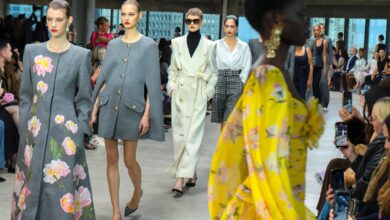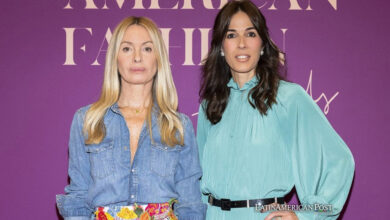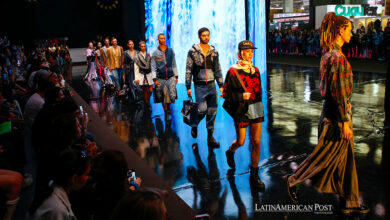Shoulder pads: a trend that struggles for equality
Listen this article
By 2019, the shoulder pads are back. We tell you about this trend and how it is related to the struggle for gender equality in the workplace

Vogue has already said that and we saw it on the catwalks of the spring/summer 2019 collections: the female shoulder pads promise a strong return for this year that has just begun. We have all seen pictures of our grandmother wearing this eighties suit with shoulder pads in her time as a worker.
Leer en español: Hombreras: una tendencia de lucha por la igualdad
In June of 2018 we saw them on the Alexander Wang catwalk in New York. Then, at Paris Fashion Week we saw them twice: in the Fall / Winter 2018-2019 collection of Saint Laurent, and in the Balenciaga Spring/Summer 2019 collection. Finally, in October 2018 we saw Lady Gaga wear an over-sized suit from Marc Jacobs, which confirmed the predictions.
When the singer, and now an actress, wore this Marc Jacobs costume, she gave a speech explaining why she wore it. Her speech ended like this: "Today I decided that I want to regain power, today I have my pants on". What does the use of this garment have to do with the feminist struggle?
Read also: Find out about the family boom in fashion
A little history
According to Julia Hobbs, for Vogue, the trend of female shoulder pads can be traced back to the 1930s, when the irreverent heiress, poet and British human rights activist, Nancy Cunard, began to wear clothes that were usually associated with the masculine, among them were the motorcyclist jacket and the blazer.
During the same decade, says Hobbs, the Italian designer and rival of Coco Chanel, Elsa Schiaparelli, moves to Paris and opens her design firm. Schiaparelli would also be very transgressive when it comes to the limits of genres in fashion: she made the jumpsuit fashionable and used several versions of the male blazer in her collections of women's clothing.
In 1945 went out Mildred Pierce, the film that narrates the rivalry between a mother who tries to climb socially (Joan Crawford) and her daughter (Ann Blyth), for the love of the same man. In Mildred Pierce, both protagonists wear suits with pronounced shoulders. Although it is not the same eighties shoulder pad later used by our grandmothers, it is the first version of this and the first time we saw it on the big screen.
Then, during the 1950s and 1960s, the figure of the good wife, the housewife of the 50s, became fashionable, so the A-cut skirt completely obscured the palisades of the shoulder pad we had seen in the first half of the twentieth century.
This, until 1980, where the shoulder pad reappeared to stay on the runways of Armani and Thierry Mugler. Since then, this garment was only on the rise: it was used mostly by women who were female power figures such as Princess Diana of Wales, British Prime Minister Margaret Tatcher and US politician Hillary Clinton.
In 1989, Working Girl premiered. In it, Melanie Grifith plays Tess McGill, a secretary who tries to break into a fierce world of work in New York City. In the end, Harrison Ford says the famous phrase "She is your man", meaning that Tess was the right person for a job.
The shoulder pads and the feminist struggle
According to the blog of the brand True Love & Poems, women's clothing was not associated with the labor field, much less with positions of power or with managing positions. The A-line skirt of the housewife is not a pledge commonly seen in the offices of law firms or brokers in New York, for example.
To this, must be added that when women entered the labor field, they did it from below: as secretaries and not as managers. Thus, when they began to ascend they were not taken seriously by men.
The working woman (the 'working girl' who represented Tess McGill) had to use fashion to make her way in companies that men ran and in which she wanted to start doing more than taking calls. This woman began to wear tailored suits just like men so they would treat them like their peers.
This was not all nor was it enough. The women also had to change their figure: hence the shoulder pads.
The jacket with shoulder pads widens the back and makes see a larger and wider woman, which made men could conceive it as a couple or a colleague. This was accompanied with a skirt and not with pants, because women could not look too threatening to men. They wanted to be taken seriously by their male colleagues but not that they believed they were coming to replace them.
In this sense, the eighties shoulder pad was a mixture of female submission and struggle for labor equality, because while women claimed the position they deserved in the workplace, they also took care not to be too threatening to men.
The shoulder pads in 2019
It is understandable to think that this garment was the tool that women workers during the 80s had on hand to be taken seriously: 'disguise' men. Hence the "She is your man", Harrison Ford to refer to a woman who is qualified for a job: she is a man.
We would think that by this 2019 it is not necessary to disguise ourselves as men to be taken seriously in the workplace and that a man can conceive as a woman a skirt and make-up as well as a man with pants and a tie. However, according to the figures of the International Labor Organization (ILO), the gender wage gap has increased in the last year from 16 to 19% worldwide.
Perhaps this is why Lady Gaga still feels that she must "have the panatalones well-placed" to "regain power" and perhaps the return of this trend is a response to this phenomenon. It seems that women should still show that they have the same wide back to receive the same salary.
LatinAmerican Post | Juliana Rodríguez Pabón
Translated from "Hombreras: una tendencia de lucha por la igualdad"




